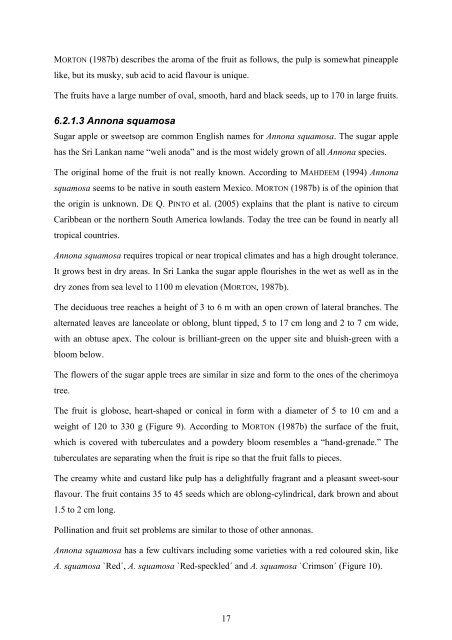Botryodiplodia sp. - Crops for the Future
Botryodiplodia sp. - Crops for the Future
Botryodiplodia sp. - Crops for the Future
You also want an ePaper? Increase the reach of your titles
YUMPU automatically turns print PDFs into web optimized ePapers that Google loves.
MORTON (1987b) describes <strong>the</strong> aroma of <strong>the</strong> fruit as follows, <strong>the</strong> pulp is somewhat pineapple<br />
like, but its musky, sub acid to acid flavour is unique.<br />
The fruits have a large number of oval, smooth, hard and black seeds, up to 170 in large fruits.<br />
6.2.1.3 Annona squamosa<br />
Sugar apple or sweetsop are common English names <strong>for</strong> Annona squamosa. The sugar apple<br />
has <strong>the</strong> Sri Lankan name “weli anoda” and is <strong>the</strong> most widely grown of all Annona <strong>sp</strong>ecies.<br />
The original home of <strong>the</strong> fruit is not really known. According to MAHDEEM (1994) Annona<br />
squamosa seems to be native in south eastern Mexico. MORTON (1987b) is of <strong>the</strong> opinion that<br />
<strong>the</strong> origin is unknown. DE Q. PINTO et al. (2005) explains that <strong>the</strong> plant is native to circum<br />
Caribbean or <strong>the</strong> nor<strong>the</strong>rn South America lowlands. Today <strong>the</strong> tree can be found in nearly all<br />
tropical countries.<br />
Annona squamosa requires tropical or near tropical climates and has a high drought tolerance.<br />
It grows best in dry areas. In Sri Lanka <strong>the</strong> sugar apple flourishes in <strong>the</strong> wet as well as in <strong>the</strong><br />
dry zones from sea level to 1100 m elevation (MORTON, 1987b).<br />
The deciduous tree reaches a height of 3 to 6 m with an open crown of lateral branches. The<br />
alternated leaves are lanceolate or oblong, blunt tipped, 5 to 17 cm long and 2 to 7 cm wide,<br />
with an obtuse apex. The colour is brilliant-green on <strong>the</strong> upper site and bluish-green with a<br />
bloom below.<br />
The flowers of <strong>the</strong> sugar apple trees are similar in size and <strong>for</strong>m to <strong>the</strong> ones of <strong>the</strong> cherimoya<br />
tree.<br />
The fruit is globose, heart-shaped or conical in <strong>for</strong>m with a diameter of 5 to 10 cm and a<br />
weight of 120 to 330 g (Figure 9). According to MORTON (1987b) <strong>the</strong> surface of <strong>the</strong> fruit,<br />
which is covered with tuberculates and a powdery bloom resembles a “hand-grenade.” The<br />
tuberculates are separating when <strong>the</strong> fruit is ripe so that <strong>the</strong> fruit falls to pieces.<br />
The creamy white and custard like pulp has a delightfully fragrant and a pleasant sweet-sour<br />
flavour. The fruit contains 35 to 45 seeds which are oblong-cylindrical, dark brown and about<br />
1.5 to 2 cm long.<br />
Pollination and fruit set problems are similar to those of o<strong>the</strong>r annonas.<br />
Annona squamosa has a few cultivars including some varieties with a red coloured skin, like<br />
A. squamosa `Red´, A. squamosa `Red-<strong>sp</strong>eckled´ and A. squamosa `Crimson´ (Figure 10).<br />
17

















